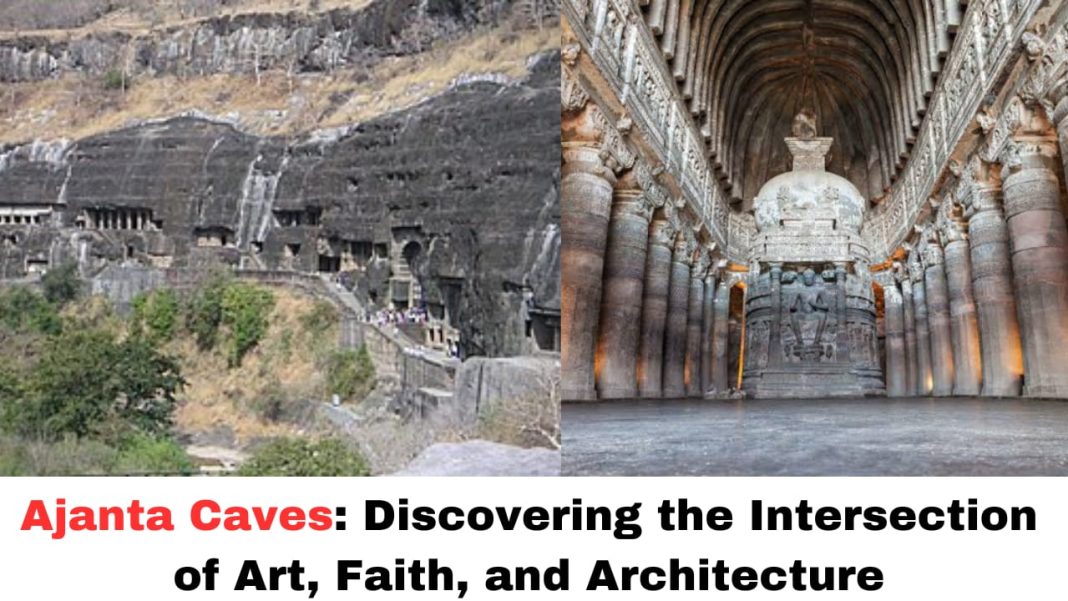Digital News Guru Education Desk:
The Ajanta Caves: Exploring India’s Rich Buddhist Heritage and Art
The Ajanta Caves, a stunning complex of ancient rock-cut Buddhist monasteries and temples, represent one of India’s most important cultural and historical treasures. Located in the state of Maharashtra, about 100 kilometers north of the city of Aurangabad, these caves are famous not only for their historical significance but also for their breathtaking art and architecture. The Ajanta Caves are recognized as a UNESCO World Heritage Site, reflecting their importance both as an architectural feat and as a repository of India’s rich Buddhist heritage.
Historical Background
The history of the Ajanta Caves is steeped in mystery. The caves are believed to have been excavated between the 2nd century BCE and the 6th century CE, primarily during two distinct phases: the first between the 2nd and 1st centuries BCE, and the second between the 5th and 6th centuries CE. The caves were initially used by Buddhist monks as monasteries and centers of learning, where they lived, meditated, and studied. Over time, these caves evolved into important religious sites that housed temples dedicated to the teachings of the Buddha.
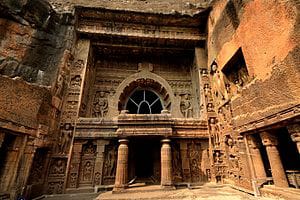
The first phase of the caves corresponds to the period of the early Buddhist “Hinayana” tradition, which is marked by simple and austere structures. The second phase, however, corresponds to the “Mahayana” tradition, which was more inclusive and saw the rise of vibrant frescoes and sculptures. The caves were gradually abandoned around the 6th century, possibly due to the rise of Hinduism in the region or the decline of Buddhist patronage.
For many centuries, the Ajanta Caves lay forgotten in dense jungle until they were rediscovered by a British officer named John Smith in 1819. This rediscovery led to extensive archaeological work, which uncovered their rich artistic and religious significance.
Architecture and Layout
The Ajanta Caves consist of 30 caves carved into the rock face of a gorge along the Waghora River. These caves are divided into two main categories: chaityas (prayer halls) and viharas (monasteries). The chaityas are the larger, more elaborate caves designed for congregational prayers, while the viharas are smaller caves intended for meditation and the daily lives of the monks.
The caves were carved out of solid rock with remarkable precision, showcasing the skill of ancient Indian craftsmen. The intricate carvings and sculptures reflect the zenith of Indian rock-cut architecture, with elaborate facades, impressive doorways, and finely detailed reliefs. One of the most significant aspects of the caves is their sophisticated planning and layout. Many of the caves are adorned with beautifully crafted sculptures of Buddha, Bodhisattvas, and scenes from the life of the Buddha, illustrating key moments from his birth, enlightenment, and teachings.
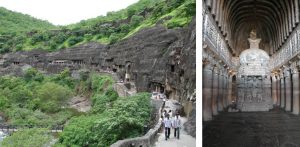
Famous Caves and Their Features
Among the Ajanta Caves, Cave 1 and Cave 2 are two of the most notable. Cave 1, the largest of the monasteries, contains an awe-inspiring fresco of a seated Buddha surrounded by intricate depictions of Bodhisattvas, gods, and celestial beings. The frescoes in this cave are among the best-preserved in Ajanta, illustrating the influence of both Indian and Hellenistic art. These paintings depict stories from the life of the Buddha and other Jataka tales, which are stories about the Buddha’s previous lives.
Cave 2, another major cave, is famous for its massive central Buddha statue and detailed paintings on the walls. The murals inside Cave 2 provide a glimpse into the advanced techniques of Indian painters from the 5th century, showcasing their command over shading, proportion, and perspective.
Other noteworthy caves include Cave 4, which houses a large and well-preserved chaitya hall, and Cave 26, which contains a grand sculpture of the reclining Buddha. The murals and sculptures in these caves are a mix of Hellenistic, Indian, and Persian artistic influences, a testament to the rich cultural exchange that took place along the trade routes of ancient India.
The Art and Murals of Ajanta
One of the most remarkable features of the Ajanta Caves is their frescoes and murals, which depict scenes from the life of the Buddha, the Jataka tales, and Buddhist cosmology. These murals offer an invaluable window into the artistic and cultural practices of ancient India, and their vibrant colors and intricate designs continue to fascinate visitors and scholars alike.
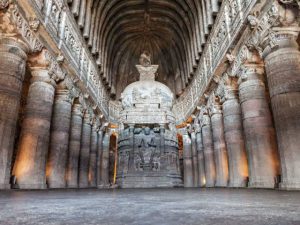
The paintings in Ajanta are made with natural pigments, and many of them have survived for over 1,500 years, although they are now somewhat faded. The vibrant depictions of royal courts, nature, animals, and everyday life in ancient India provide a glimpse into the socio-cultural environment of the time. The detailed murals not only convey religious messages but also reflect the diversity and complexity of ancient Indian society.
Religious and Cultural Significance
The Ajanta Caves are not just an artistic treasure; they are also an important pilgrimage site for Buddhists. The caves are associated with the teachings of the Buddha and were used by monks for meditation and instruction. The frescoes and sculptures were created to inspire devotion and provide an educational tool for both the monks and the laypeople who visited the site.
Buddhist monks used these caves as centers of worship and learning. The caves provided a peaceful environment for meditation, and the art inside the caves was designed to aid in spiritual development. The influence of Buddhist thought and culture is clearly visible in the design and iconography of the caves, and they continue to be a source of inspiration for followers of the Buddhist faith.
Preservation and Modern-Day Importance
Today, the Ajanta Caves are an invaluable part of India’s cultural heritage. They were designated as a UNESCO World Heritage Site in 1983, ensuring their protection and preservation for future generations. The caves are managed by the Archaeological Survey of India (ASI), which works to maintain the site’s integrity and prevent further damage to the ancient murals and sculptures.
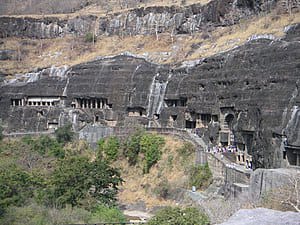
The Ajanta Caves are also a major tourist attraction, drawing visitors from around the world. They provide a unique opportunity to experience ancient Indian art, architecture, and religious practices in their original setting. In addition to their artistic and religious significance, the caves also hold immense historical value, as they represent the peak of ancient Indian rock-cut architecture.
Conclusion
The Ajanta Caves stand as one of India’s most extraordinary achievements in art and architecture. With their stunning murals, intricate sculptures, and rich history, they offer a glimpse into the spiritual and cultural life of ancient India. Whether you are an art enthusiast, a historian, or a spiritual seeker, the Ajanta Caves offer a profound experience that continues to inspire awe and wonder. Their timeless beauty and significance ensure that they will remain a cherished part of India’s cultural landscape for centuries to come.
The Ajanta Caves serve as a powerful reminder of the skill, creativity, and spirituality of ancient Indian civilization, and they continue to captivate people from all walks of life.
You May Also Read: Manish Malhotra’s First Film Production: A Suspenseful Debut with Saali Mohabbat



